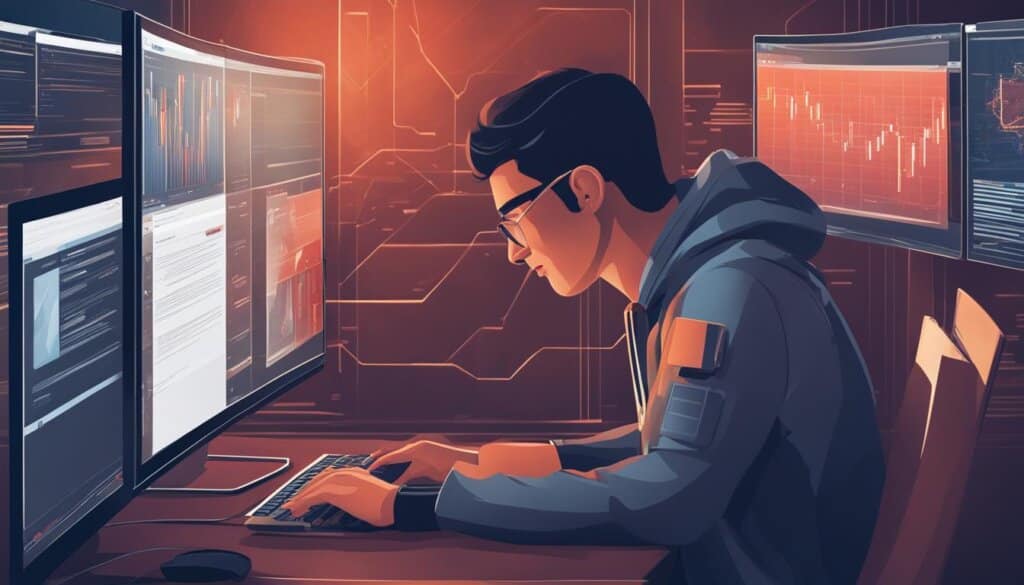Table of Contents
Welcome to our brief guide on peer-to-peer (P2P) technology. In this article, we will explore the concept of P2P, its decentralized communications model, and its impact on file sharing and network architecture. So, let’s dive in and explore the world of P2P!
Peer-to-peer (P2P) is a decentralized communications model that revolutionized the way information is shared and transmitted across networks. Unlike the traditional client-server model, P2P allows each node to function both as a client and a server, enabling direct communication between computers. This distributed approach eliminates the need for a central server and empowers each node with the same capabilities, creating a more resilient and efficient network structure.
P2P technology gained popularity with the emergence of music-sharing platforms like Napster, Gnutella, and BitTorrent. These applications allowed users to share files directly with one another, bypassing the need for a central authority. However, due to its potential to tie up bandwidth, bypass firewalls, and distribute malware, P2P usage remains a topic of caution for network administrators.
In the next sections, we will delve deeper into how P2P networks work, the different types of P2P file sharing, the benefits and risks associated with P2P file sharing, and tips for safe and legal practices. By the end of this guide, you will have a comprehensive understanding of P2P technology and its impact on the digital landscape.
How do P2P Networks Work?
In a P2P network, when a user downloads a file, the process is different from traditional client-server networks. Instead of downloading from a central server, the user’s computer connects to a virtual network of P2P application users. The file is downloaded in bits from various computers in the network that already have the file. Data also travels from the user’s computer to other computers in the network when requested. This two-way communication allows the load to be distributed between the peer computers. P2P networks typically operate in a decentralized architecture where each computer has the same responsibilities and capabilities.
P2P networks enable users to share and download files directly from other users. This decentralized approach eliminates the need for a central server, making it more efficient and resilient. The key concept behind P2P networks is that every participant becomes both a consumer and contributor, forming a interconnected web of nodes.
Benefits of P2P Networks:
- Efficient file sharing: P2P networks allow for faster file transfers as the load is distributed across multiple users.
- Increased availability: By leveraging resources from multiple computers, P2P networks ensure files are readily available even if one user goes offline.
- Resilience: The decentralized nature of P2P networks makes them resilient to failures as there is no single point of failure.
Risks of P2P Networks:
- Malware and viruses: P2P networks are susceptible to malicious software and infected files, which can be inadvertently downloaded.
- Copyright infringement: Users may share copyrighted material without permission, leading to legal consequences.
- Privacy concerns: As files are shared directly between users, there is a risk of exposing personal information to unknown parties.
Understanding how P2P networks work is crucial for both users and network administrators. By being aware of the benefits and risks, users can make informed decisions and take appropriate measures to ensure a secure and responsible P2P file sharing experience.
| Centralized P2P Networks | Decentralized P2P Networks |
|---|---|
| Managed by a central server | No central server |
| Files stored on the central server | Files distributed across network nodes |
| Users connect to the central server to share and download files | Users directly connect with other users to share and download files |
| Examples: Napster, Limewire | Examples: BitTorrent, Kazaa |
Types of P2P File Sharing
In the world of P2P file sharing, there are two main types of networks: centralized and decentralized. Each plays a unique role in facilitating the exchange of data among users. Let’s explore each type in more detail:
Centralized P2P Networks
In centralized P2P networks, a central server acts as a hub for managing the network and storing shared files. This server plays a crucial role in connecting users and facilitating file transfers. Users connect to the central server to search for files or upload their own files to be shared with others. Centralized P2P networks were popular in the early days of P2P file sharing and paved the way for the development of this technology.
An example of a centralized P2P network is Napster, a groundbreaking music-sharing platform that revolutionized the way people accessed and shared music. Another example is Limewire, which allowed users to search and download various types of files from its central server.
Decentralized P2P Networks
Decentralized P2P networks, in contrast, operate without a central server. Each device connected to the network acts both as a client and server, enabling direct file sharing between users. This decentralized architecture removes the reliance on a central authority and empowers users to connect and share files without intermediaries.
A notable example of a decentralized P2P network is BitTorrent. It allows users to download files from multiple sources simultaneously, taking advantage of the collective resources of the network. Kazaa is another example of a decentralized P2P network that gained popularity in the early 2000s, offering a wide range of files for download.
Decentralized P2P networks offer increased resilience, as they are not dependent on a single server that can be a point of failure or vulnerable to attacks. Each device participating in the network contributes to the overall availability and accessibility of shared files.
Here is a visual representation of the differences between centralized and decentralized P2P networks:
| Centralized P2P Networks | Decentralized P2P Networks |
|---|---|
| Relies on a central server | No central server |
| Connects users to the central server for file sharing | Direct file sharing between users |
| Example: Napster, Limewire | Example: BitTorrent, Kazaa |
To better understand the differences, visualize the centralized P2P network as a spider-like structure with a central server at the core, while the decentralized P2P network resembles a web with interconnected devices forming the network fabric.
Next, we’ll explore the benefits and risks of P2P file sharing. Understanding these aspects is vital for users wishing to engage in safe and legal P2P file sharing practices.
Benefits and Risks of P2P File Sharing
P2P file sharing offers several benefits that have contributed to its popularity among users. One of the primary advantages is efficient data transfer. Unlike traditional client-server networks, P2P allows files to be downloaded from multiple sources simultaneously. This parallel downloading process significantly reduces download time and enhances overall speed.
Additionally, P2P file sharing minimizes lag time, as users can start accessing and streaming content as soon as the download begins. This real-time streaming capability allows for seamless playback of music, movies, and other media files, providing a better user experience.
Another notable benefit of P2P file sharing is the reduced reliance on centralized servers. In client-server networks, the server can become overwhelmed and experience downtime due to heavy traffic or technical issues. P2P networks distribute the load across multiple users, eliminating the risk of a single point of failure and ensuring uninterrupted access to shared files.
However, alongside these benefits, there are also risks associated with P2P file sharing that users need to be aware of. One of the main concerns is the unintentional distribution of copyrighted material. Since P2P networks facilitate the sharing of files between users, there is a possibility of sharing copyrighted content without permission, unknowingly exposing oneself to legal consequences.
P2P networks are also susceptible to viruses, malware, and cyberattacks. Since files are shared directly between users, there is a risk of downloading infected files that can harm one’s device or compromise personal information. It is crucial to exercise caution, use reputable P2P software, and regularly scan downloaded files for viruses and malware to mitigate these risks.
Overall, P2P file sharing offers undeniable benefits in terms of efficient data transfer, reduced lag time, and decreased reliance on centralized servers. However, it is crucial for users to be aware of the risks involved and take necessary precautions to ensure safe and legal P2P file sharing.
Benefits of P2P File Sharing:
- Efficient data transfer
- Less lag time
- Reduced reliance on centralized servers
Risks of P2P File Sharing:
- Unintentional distribution of copyrighted material
- Vulnerability to viruses, malware, and cyberattacks

Tips for Safe and Legal P2P File Sharing
When engaging in P2P file sharing, it is crucial to prioritize safety and legality. One of the first steps is to use reputable software such as uTorrent or BitTorrent. These platforms have a longstanding reputation for providing secure and reliable file sharing services. By using reputable software, you reduce the risk of downloading files that may contain viruses, malware, or other harmful content.
Another important aspect of safe and legal P2P file sharing is to avoid sharing copyrighted material. Sharing copyrighted files without permission is illegal and can lead to legal consequences. It is essential to respect intellectual property rights and only share files that you have the legal right to distribute. This not only safeguards you from legal troubles but also helps support artists and content creators.
Protecting your personal information is paramount while engaging in P2P file sharing. Avoid sharing sensitive data such as your full name, address, or financial details. Additionally, use strong passwords to secure your P2P software accounts and prevent unauthorized access. Regularly changing passwords and using a combination of letters, numbers, and symbols can significantly enhance cybersecurity.
Lastly, ensure the safety of your computer and network by regularly scanning downloaded files for viruses and malware. Use reputable antivirus software to scan files before opening or executing them. It is also advisable to keep your firewall enabled to protect against potential threats. Be cautious of suspicious pop-ups or links and only download files from trusted sources. By following these tips, you can enjoy a secure and legal P2P file sharing experience.
FAQ
What is P2P (peer-to-peer)?
P2P is a decentralized communications model in which each party has the same capabilities and can initiate communication sessions. It allows each node to function as both a client and server.
How do P2P networks work?
In a P2P network, when a user downloads a file, their computer connects to a virtual network of P2P application users. The file is downloaded in bits from various computers that already have the file, and data also travels from the user’s computer to other computers when requested.
What are the types of P2P file sharing?
P2P file sharing can be categorized into centralized and decentralized networks. Centralized networks have a central server that manages the network and stores shared files, while decentralized networks operate without a central server, allowing direct file sharing between devices.
What are the benefits and risks of P2P file sharing?
P2P file sharing offers benefits such as efficient data transfer, less lag time, and reduced reliance on centralized servers. However, there are also risks associated with P2P file sharing, including the unknowing distribution of copyrighted material and vulnerabilities to viruses, malware, and cyberattacks.
How can I ensure safe and legal P2P file sharing?
To ensure safe and legal P2P file sharing, it is recommended to use reputable software, avoid sharing copyrighted material, protect personal information, regularly scan downloaded files for viruses and malware, keep firewalls enabled, and be cautious of suspicious pop-ups or links.












